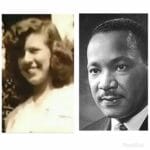Bound by Love, Divided by Freedom: The Story of John and Harriet Tubman
Harriet Tubman’s life is a testament to extraordinary courage and her unwavering commitment to freedom. Yet, intertwined with her heroism is a deeply personal and heart-wrenching chapter: her marriage to John Tubman. Their story, while less widely known, offers a poignant glimpse into the complexities of love, sacrifice, and survival during the era of slavery.
When Harriet, then known as Araminta “Minty” Ross, married John in 1844, their union held a glimmer of hope in a world marred by oppression. John, a free Black man, represented a stark contrast to Harriet’s reality as an enslaved woman. This difference in social standing, however, would soon cast a long shadow over their marriage.
In 1849, fueled by an insatiable thirst for freedom, Harriet embarked on a perilous journey north via the Underground Railroad. It was a journey she would make alone. John, despite his love for Harriet, made the agonizing decision to stay behind.
Why he made this choice remains a subject of debate among historians. Some theorize that John, like many free Black individuals at the time, was paralyzed by the immense risks associated with aiding someone’s escape from slavery. Recapture meant almost certain brutality and potentially death, not only for the escaped individual but also for anyone who assisted them. It’s also plausible that John, deeply rooted in his community, felt bound by family ties or responsibilities he simply couldn’t abandon.
Despite their divergent paths, Harriet and John’s bond endured. They maintained a connection through letters, their words bridging the distance and the increasingly disparate realities of their lives. It is even suggested that John visited Harriet years later, a testament to the enduring power of their connection.
A Husband Left Behind: John Tubman After the Escape
While Harriet Tubman’s name became synonymous with the fight for abolition, John Tubman’s life took a different course. Following Harriet’s departure, the details of his life become shrouded in the mists of time, a consequence of the historical silences that often surround the experiences of Black individuals during this period.
What we do know is that by 1851, John had remarried, taking a woman named Caroline as his wife. This union, while sparsely documented, speaks to the realities of life in antebellum Maryland. It is possible that John, facing the daunting prospect of navigating life alone, sought solace and companionship in a new relationship. The circumstances surrounding his choice to remarry, however, remain largely unexplored.
John’s life ended tragically in 1867. He was killed during an altercation with a white man named Robert Vincent in Dorchester County, Maryland. The precise events leading to his death remain unclear, and like many aspects of John’s life, the lack of detailed documentation adds another layer of complexity to his story. His death, however, serves as a stark reminder of the pervasive dangers faced by Black people, both free and enslaved, even after the official end of slavery.
Two Paths, One Legacy: The Enduring Significance of John and Harriet Tubman
Harriet eventually found love again after the Civil War, marrying Nelson Davis, a Civil War veteran. Their life together in Auburn, New York, centered around family, with Harriet dedicating herself to caring for her aging parents and other relatives.
John Tubman’s story, though fragmented, provides a valuable lens through which to view the experiences of Black men during this turbulent period. His decision to remain in Maryland, whether driven by fear, a sense of responsibility, or a combination of factors, illustrates the limited options available to those trapped within the suffocating constraints of a society deeply entrenched in racism.
While Harriet’s narrative rightfully stands as a beacon of resistance and courage, John’s story reminds us that the fight for freedom was often waged on multiple fronts, each individual grappling with impossible choices in the face of unimaginable adversity. Their stories, viewed together, paint a richer, more nuanced portrait of the intricate and enduring legacies forged during one of the darkest chapters in American history.
Meet Another Formidable Figure: Hermilda de los Dolores Gaviria Berrío
John and Harriet Tubman’s story is just one of many fascinating narratives from history. To broaden your understanding of resilience and strength in the face of adversity, we encourage you to explore the life of another compelling figure: Hermilda de los Dolores Gaviria Berrío. Her story is sure to captivate and leave a lasting impression.
- Unlock Filipino Culture: A Deep Dive into Traditions and Practices - April 23, 2025
- Unlock Spanish Culture: Insights & Opportunities Now - April 23, 2025
- White Spirit Uses & Substitutes: A Deep Dive for Pros & DIYers - April 23, 2025

















1 thought on “Harriet Tubman’s Heartbreak: The Free Husband She Left Behind”
Comments are closed.